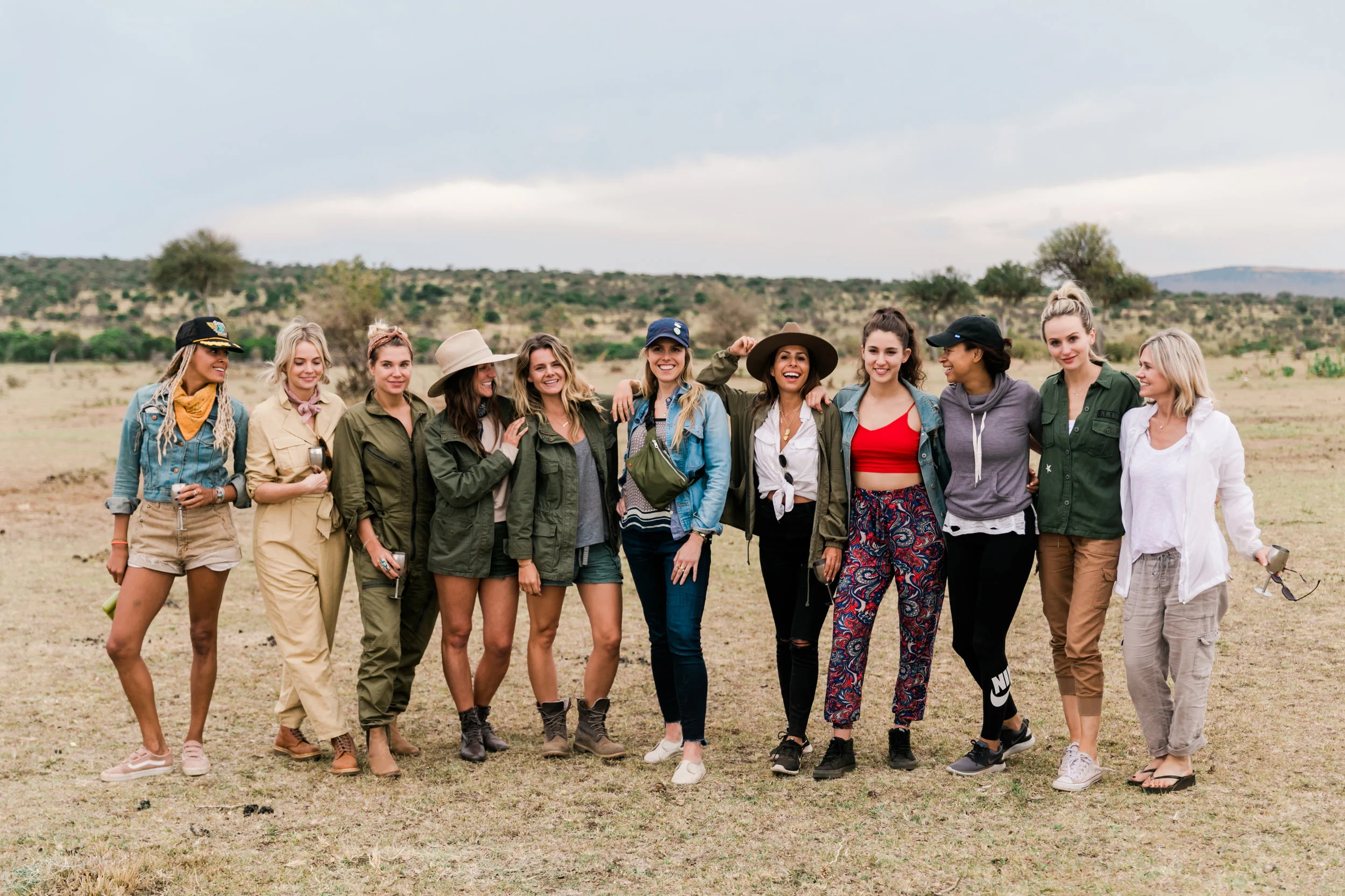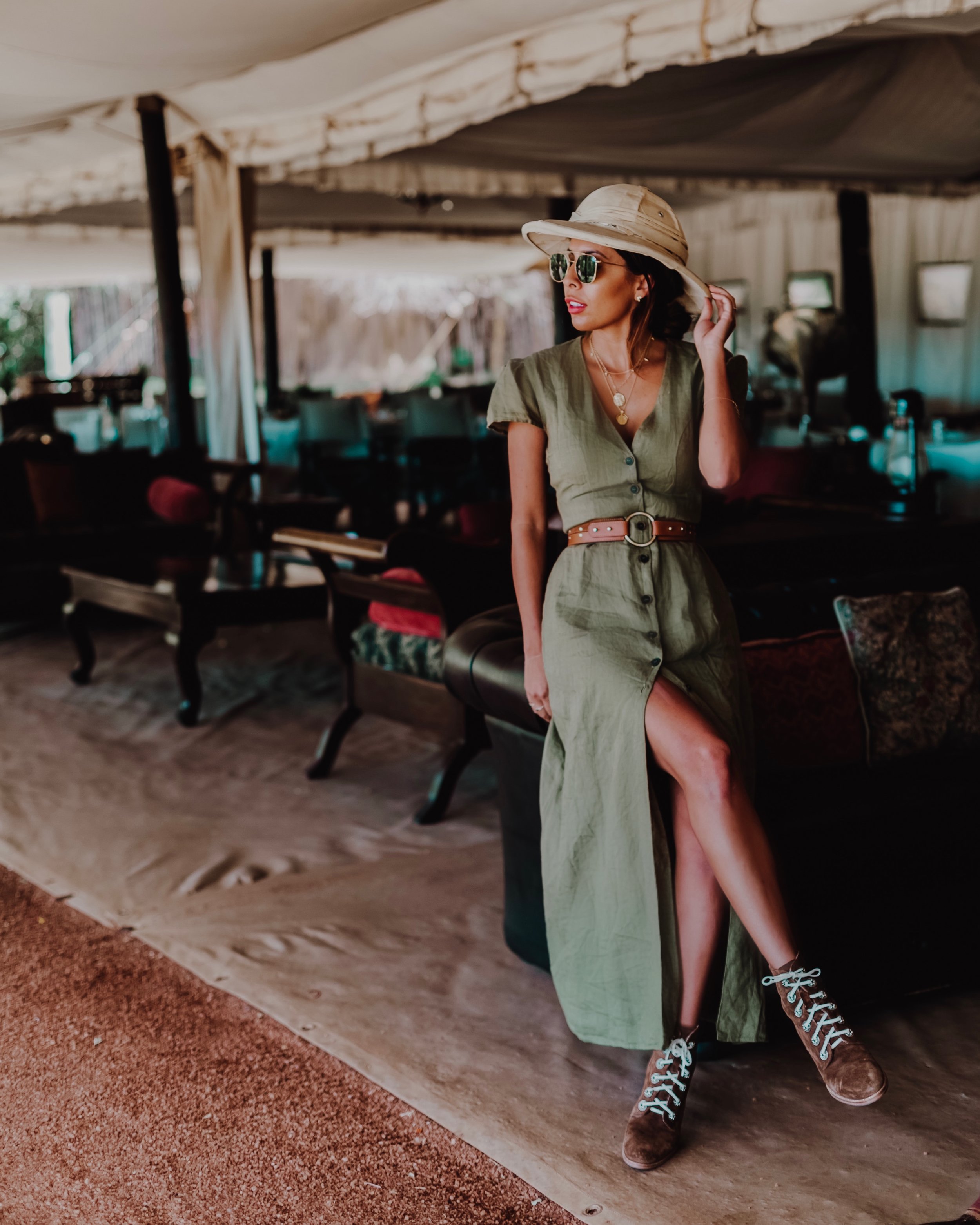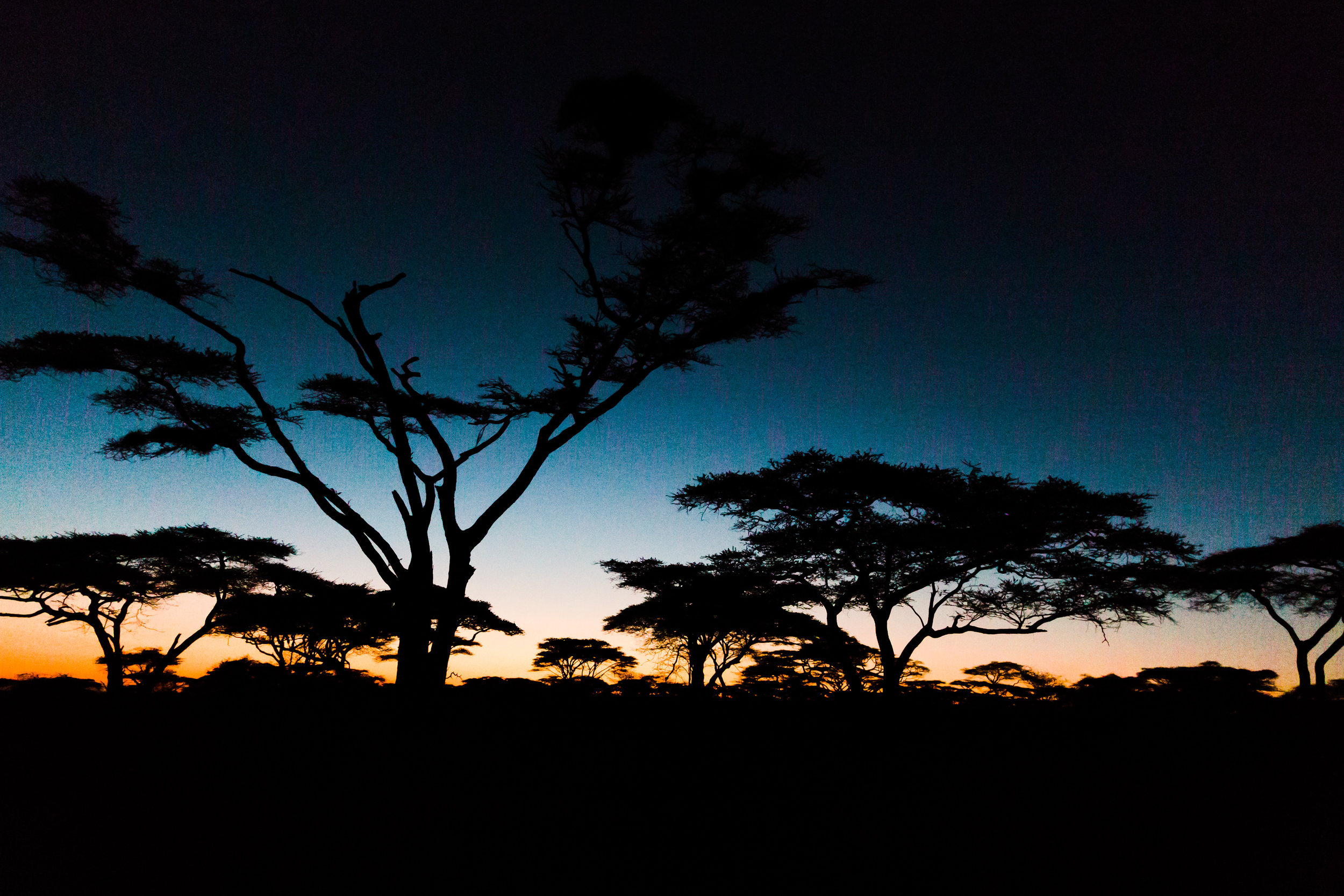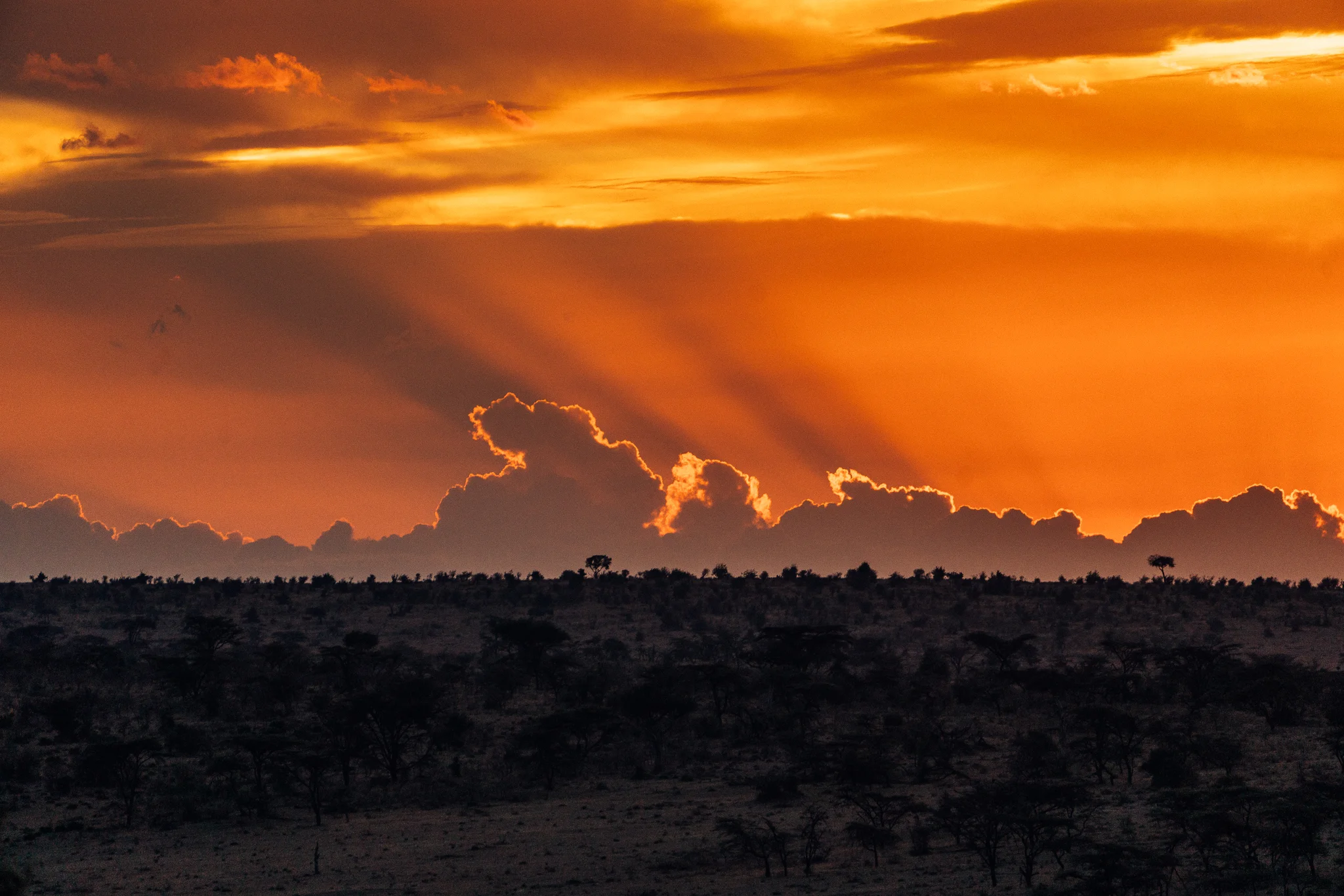Kin Kenya: Safari at Cottars 1920s
Africa is in your soul… you just might not know it until you get here.
-Calvin Cottar, Cottars 1920s Safari Camp
Exactly a month ago we embarked on an incredible adventure through the Maasai Mara in Kenya, Africa with Kin Travel + Cottars 1920s Safari Camp. I’d be lying if I said I wasn’t still trying to digest everything that our trip gave to us, from the beautiful people we met to the pure majesty of the wildlife; safari is truly a life changing experience.
2022 update: Kin Travel is helping travelers plan Safaris to camps and conservancy areas in Botswana, South Africa, Zimbabwe or Namibia plus experiences on the beaches of Cape Town or Mozambique.
I’ve put together three posts related to my trip: how to prep for Safari in Africa, Safari FAQs, and this one. This one takes you in-depth (via words + images) of our 6 day Kin Travel x Cottars 1920s Safari experience. On our last night in the Maasai Mara, as I reflected on our experience with the group at dinner, I said “there are no blog posts, no photos, no captions, and no videos that can do justice to the feeling of experiencing safari in Africa.” It’s an indescribable feeling, so pure and happy… one I pray that our future generations will be able to experience which is really the main goal of Kin Travel x Cottars 1920s: preservation of biodiversity, sustainability, and conservancy. I’ll dive deeper into this towards the end of this post plus don’t forget to checkout my FAQ page for more details.
But first, let’s go on safari:
Day 1
We arrived in Nairobi very early in the AM after 25+ hours of travel. Exhausted? Yes! Adrenaline pumping and ready for adventure? Yes and yes!! After meeting the rest of the group (15 of us) at a local hotel we got a quick briefing about our upcoming experience then headed to a small airport where we boarded what I call a “baby plane.” The baby plane is what dictates your packing list (yay weight limit!) and also may put your emotions to the test. Andy and I flew on small planes during our recent honeymoon in Belize, so I’m pretty comfortable with them but it’s definitely a little nerve wracking if you’ve never been on one before. Of course, we all made it safe + sound after getting an incredible aerial view of the Maasai Mara.
What’s the Maasai Mara? According to the google: The Maasai Mara is an area of preserved savannah wilderness in southwestern Kenya, along the Tanzanian border. Its animals include lions, cheetahs, elephants, zebras and hippos. Wildebeest traverse its plains during their annual migration. The landscape has grassy plains and rolling hills, and is crossed by the Mara and Talek rivers. The area nearby is dotted with villages of Maasai people.
It’s also commonly referred to as “THE BUSH” which I’ll use throughout this post.
Once we landed in the bush we were greeted by our hosts Chris, Wilson, Maco, Matura, and other Maasai guides on the Cottars 1920s Safari team. I’m not kidding when I say it felt like we landed in the middle of nowhere. There was open land as far as the eye could see aside from our open air Land Cruisers which served as our vehicles the entire trip. First order of business: a game drive en route to Fly Camp.
The term “GAME DRIVES” stems from the old big game hunting Safaris of the past (hunting has been outlawed in the Maasai Mara since the 1970s) and now is the viewing of wildlife from an open air vehicle. It’s an activity we did EVERY DAY at on our trip (because, ANIMALS!!) and is such an awesome experience.
On our first game drive to camp we had no idea what to expect. Within minutes we were rolling up to droves of wildebeest and zebras. I’m not kidding when I say it felt like the Lion King. Speaking of the Lion King, you know when the wildebeest kill Mufasa? This scene was taken from the great migration - when the animals make their way across the Serengeti Plains from Tanzania into the Maasai Mara and back. During our trip (end of October) we were lucky enough to get the tail end of the great migration and to see thousands of wildebeest and zebras.
The first two nights of our trip we stayed at Cottars’ newly established Fly Camp. The Kin Kenya trip was born from a creative concept between Brian (founder of Kin) and Calvin Cottar (3rd generation owner of Cottars 1920s camp) as they approached their 100th year anniversary. The result is a mobile tented camp like the hunting outfits that roved the plains with wildlife as the Cottar family once did in the 1920's, journeying from this beginning through time to the luxury camp. Simple tents amid the plains and wildlife with a full staff, camp kitchen & hot gravity showers hung from acacia trees -all entirely off-grid and under stars. Think simple luxury with a camp fire each night.
Just as we were greeted upon landing in the Mara, the Maasai team greeted us with kind smiles and open arms. They had already put our luggage in our tents and our only responsibility was to have a cocktail and get to know each other!
That evening, after a full day of travel, we were pretty exhausted (hello, jet lag!) but fought it to enjoy a yummy dinner, warm campfire and glorious welcome blessing/tribal dance from our Maasai friends. Checkout my IG highlight for some fun video of that night.
DAY 2
The team generously gave us a late wake up ie: 7:30am - haha. We all joked that the cots may have been the comfiest beds we had ever slept in. That, or we were just seriously tired and jet lagged. For breakfast we feasted on french press coffee, fresh fruit, pancakes, and eggs; all so delicious! Then we embarked on a 3 hour game ride and that’s when we saw ALL. THE. ANIMALS:
Elephants, giraffes, lions, wildebeest, antelope, warthogs, zebras, and impalas to name a few!
It was SPECTACULAR! There are seriously no words to describe how majestic the animals are in the wild. It’s pretty nuts how close we were able to get to them as well. Checkout my IG highlight to see all the vids; we’re talking lions less than 5 feet away. You’re probably wondering if I was ever scared? The answer is no. The Maasai guides who have invited us into their homes are protecting us and guiding us. They are not only trained warriors with extensive knowledge of the land and wildlife, they are also the kindest humans I’ve ever met. Our long game drives were filled with nature, learning, and friendship building. The Maasai guides know EVERYTHING there is to know and my inquisitive husband was always drilling them on this that and the other. We became so close to Mako, Wilson, and Matura over our 6 days my eyes tear just thinking about them!
One of the more peculiar things we learned is that the Maasai don’t keep track of their birth dates, so when you ask their age they say a range. Wilson told us he was somewhere between 25 + 30. My response: umm, I LIKE THIS. I’m going to start telling people that any time they ask! Many of them have started to give themselves birthdates for one particular reason: Facebook. You can’t create a Facebook account without one and therefore they all have arbitrary birthdays for the sake of social media!
After our wildlife-filled game drive we headed back to camp for yummy fish tacos and a little down time before we headed out again to visit a local school.
Visiting the school was so special. If you haven’t noticed there’s a theme on this trip aka ALL THE FEELS. As we drove to the school we learned that all kids have to walk to school every day… potentially by lions + elephants … and typically many many miles. The life of the Maasai tribes of Kenya and Tanzania revolve around cattle, therefore education isn’t the main priority. On our drive we saw many small boys (ages 5+) who were out herding and watching over cattle and sheep. Typically only one child per family is sent to school which is roughly $250 per year. It’s also not surprising to see education priority go to boys vs. girls. If you watch my IG highlight you’ll see that enrollment of girls drops off significantly around grade 4/5 because this is when they start getting their periods. With very limited access to sanitary napkins, girls can’t attend school for 4 - 7 days per month during their periods and often drop out. If you’re interested in learning more about this and making an impact, I suggested checking out Pads4girls. Once girls start menstruating this also means they are ready to marry and bare children which is another reason they drop out of school.
On a positive note, the kids were ecstatic to see us! We played soccer with them and fun clapping games. Most speak Ma (Maasai language) and are learning Swahili. Although they don’t really know english their favorite Qs to ask us were:
What’s your name? How old you are? How many brothers you have?
Always in that order and over and over again. It was the cutest! Their smiles exude pure joy and it was such a treat to meet them. Another reason why we stopped to see the school is because part of our Kin Trip fee covered Lifestraw water filtration units in 2 of the 6 schools in the conservancy, meaning roughly 1000 primary school students now have access to clean, potable water. Lifestraws program not only includes recurring hygiene trainings and classes for the kids but also provides 5 years of quarterly follow-ups to assure the filters are in tip-top shape and being used.
We ended the day with sunset drinks in the bush while giraffes walked by us and then dinner with Calvin Cottar (owner of Cottars). Safe to say our first full day was a TREAT!
DAY 3
After our adventures in the bush at “Fly Camp” it was time for us to head to 4 nights of pampering at Cottars 1920's Luxury Camp. We embarked on a bush walk early in the morning to make our way to our next home. Most people tapped out after an hour or so but in that time we literally WALKED with giraffes (watch my IG highlight to see)! This was the only time there was any gun presence on our trip. Kin hired guards from the reserve to walk with us as extra precaution.
One thing I forgot to mention (there’s so many things!) is the difference between the conservancy the Maasai Mara National Reserve. Cottars is on a conservancy which is owned by the indigenous tribes of the Maasai Mara vs. the National Reserve which is government owned. Per Cottars: Situated in an untouched and exclusive concession bordering the Serengeti and Maasai Mara National Reserve we are the only camp situated in the 6,000 acre conservancy. No hot air balloons flying overheard, no minibuses buzzing around, no nearby lodges and no low-flying aircraft to disturb. Most of our game drives were spent on the conservancy and the ONLY cars we ever saw were our own. When we crossed the line to the National Reserve to go to the Mara River (to see the hippos - coming soon!) I was flabbergasted at all the safari “traffic”. TONS of vans (with little windows) and other vehicles all surrounding a lion pride. I would be very disappointed with a safari experience like that, especially the limited view vehicles that customers were in. Just something to note if you’re looking into Safari experiences.
Once we arrived to luxe camp we were all ready for some much needed veg time. Hello, pool! The view from the pool was INSANE. Add a glass of South African Sauvignon Blanc and you know I was in heaven. As we were enjoying the Kenya sun we got word that a leopard had been spotted in the Mara and she had a recent kill which meant she would be there for a minute, noshing! A handful of the group went to adventure and found her (I stayed and pool’d) and said it was pretty incredible. I’ll spare you the graphic photos but this one that Andy captured is pretty awesome:
DAY 4
Our 4th day consisted of a 12 hour game drive! Yes, 12 hours. At first we thought the team was joking but we were on quest for two things: hippos and rhino. Hippos live in the Mara River which took about 5 hours to drive to because we stopped so many times to see the wildlife we encountered. That day we saw a new lion pride, cheetahs, male lions, hippos, zebra, + giraffes… and all the wildebeest.
The team packed us lunch to enjoy by the river and we had plenty of bevvies to keep us hydrated along the way. I don’t know how I’ve failed to mention the yummy white wine and Tusker beers that we enjoyed on every game drive!
On our drive back we were all hopeful that we would see a rhino but the guides hadn’t seen one since earlier in the summer. There’s only 24 rhinos in the entire Mara so spotting one is a BIG deal. After what seemed like ALL DAY (oh wait, it was) we got word on the radio that there was a rhino spotting. About an hour later, we found it! What a site to see:
DAY 5
After our full day game drive we were all in need of a chill day and that’s exactly what we did: pool’d + lunched @ the Bush Villa. In the afternoon our guides treated us to "Warrior Camp” where we all learned how to shoot bows + arrows and throw spears. I don’t want to brag but I hit the bullseye on my third attempt * thank you, thank you * By this day our group had become so close and it also felt like the guides were our family. I keep saying it, but it’s hard to express in words how this trip impacted me. Experiencing each day with the Maasai taught me how to find joy in everything and to really celebrate every new day.
You’re probably wondering about the our accommodations at the luxe camp. Cottars says it best: 1920s camp provides the romance of safari under cream canvas tents, the style of the bygone era of the twenties, while at the same time supplying the amenities required by today’s modern world travelers and professional guides whose qualifications are the highest in Africa. Offering an abundance of wildlife, a guarantee of privacy, and the highest standards of professional guiding in a luxurious and authentic camping environment. The camp has nine tents in total (one unique honeymoon tent, four double tents and four family suites), all with en suite bathrooms. The family tents have living rooms with fireplaces. The entire camp is situated to ensure that tents are private and quiet whether for honeymooners or families with young children.
It’s really like a luxe hotel just in the middle of the Maasai Mara!
DAY 6
As if I couldn’t have fallen more in love with our Maasai friends, on the 6th day we visited a Maasai Village and my heart almost burst. They are SO inviting and hospitable. We were welcomed into the village with a beautiful song and dance; the women even shared their jewelry and shuka’s with us. The Maasai men have many wives and therefore many children. They live as a family unit in villages with each wife/set of children in their own homes. There’s no running water or electricity.
Many would walk away from the village and think “they have nothing.” I beg to differ. They live simply and ARE happier than any westerner I’ve ever met. Yes, there’s basic needs like sanitary napkins, clean drinking water, access to education, and a few other things that they are struggling with. All of which we can all help make available to them. But I think the argument really is “WE have too much!” Coming back to the U.S. after this trip was a huge reality check on how our lives are driven by consumerism and excess.
Not to say we can’t enjoy the “treat yourself” moments, like the massages and bush bath we experienced when we got back to Cottars after our village visit - hah! The overall experience just helps you appreciate EVERYTHING so much more.
We closed out our last night with a candlelight dinner by the pool and another beautiful song + dance from our Maasai friends (just as we were welcomed). Yes, I cried. Saying goodbye to Kenya was tough, especially to the friends that we met while we were there. The memories we made are unparalleled and I cannot wait to go back. Keeping scrolling to read more about the Kin Travel x Cottars 1920s IMPACT.
Kin Travel x Cottars IMPACT
What is Kin Travel?
Kin curates experiences and builds community in support of sustainable tourism leaders and changemakers positively transforming communities and ecosystems. It is a member community whose dues are invested in non-profit and social enterprise partners in each destination, currently Haiti, Kenya and Wyoming, and all journeys are with partners vetted by the Global Sustainable Tourism Council and offset their carbon footprint. You can read more about my Haiti experience with Kin on this post.
What is Cottars?
Cottars is one of thirteen accredited Global Ecosphere Retreats (GER’s) in the world for their demonstrated ability and commitment to achieve sustainability through the 4Cs (conservation, community, culture and commerce). The camp is also rated Gold by the Ecotourism Society of Kenya and has won a Green Globe Award from the World Travel Market. To truly understand the camp and what they have built I highly suggest looking at the videos on this page. They have captured the essence of Cottars.
How are they working together?
Kin’s journey with Cottars affords a uniquely intimate connection with Maasai and wildlife because of their cutting-edge conservation model, generally described as ‘land-leasing.’ Over the course of 20 years, Cottars worked with all 6000 Maasai landowners to fuse their land into a 7000-acre, community-owned conservancy safeguarding wildlife, which Cottars then rents at a rate that exceeds what could be made by subdividing and fencing it for livestock or monoculture farming.
Subdivision shrinks wildlife habitat and results in the killing of animals that threaten cattle, whereas as a community who benefits from wildlife protects them.
By traveling with Kin it means you not only have the incredible privilege of investing in this work but have a very real relationship with the community and all 7000 acres of this haven to ourselves. Our investment will be directly in the Cottars Wildlife Conservation Trust (CWCT) which support a 6,000 acre wildlife conservancy which supports a critical migratory corridor for wildlife in partnership with Maasai communities. This requires management of a community of rangers to secure the animals from poachers and deforestation and structure benefits for communities linked to the thriving of a balanced ecosystem. Investing in the wellbeing of Maasai communities is a big part of this, focused primarily on education, access to medical facilities, ambulance services and a healthy water supply.
In an nutshell, if you want your children to see a lion in the wild or experience the biodiversity of Africa these are the companies who are working tirelessly to make that a real possibility. By going on a trip with Kin you are supporting the cause and amplifying the message on top of being able to have a freakin’ INCREDIBLE experience. If you aren’t able to book a safari with Kin but still want to give back, donations can be made to Africa Wildlife Foundation, who are offering their tax-exemption status to ferry those dollars to Cottars’ Wildlife Community Trust.
Kin Kenya Winter Safari 2018
* * press play * *




















































































So you’re thinking about going on Safari but have ALL the questions? Don’t worry, I got you! Giving you the 411 on flights, cost, food, bathrooms, malaria pills + more.